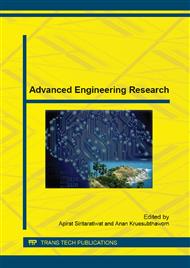p.168
p.172
p.176
p.180
p.184
p.189
p.195
p.199
p.203
DSSCs Fabrication Using Nano-Structured Titania as Photoanode
Abstract:
This project aimed to fabricate the nanostructure of titanium dioxide by one-step anodization for DSSCs. PCC and BCC set up were investigated for the oxidation of Ti-sheet in EG electrolyte consisting of 0.38%wt. NH4F and 1.79 %wt. DI water for 3 hrs, under applied potential of 10-40 V. Anodized TiO2 films were annealed at 600°C for 3 hrs to crystallize the initially amorphous anodized films. The as-prepared nanoporous-TiO2 layer obtained from anodization of Ti by using PCC was detachment flaking film, while using BCC gave the films adhered on the Ti-substrates. The most perfectly adherent nanoporous-TiO2 film was fabricated via BCC under the applied potential of 40 V for 3 hrs. This attached film on Ti substrate was used as the anode of DSSC cell which having the active area of 0.5x0.5 cm2, the investigation was done under one sun condition (AM 1.5, Pin 100 mW/cm2). A photoconversion efficiency (ɳ) of 1.198% was obtained by using annealed Ti/TiO2-nanotube/FTO based DSSC as a photoanode with a short-circuit current density (Jsc) of 2.871 mA/cm2, open-circuit voltage (Voc) of 0.794 V and fill factor (FF) of 0.526. This overall photoconversion efficiency (ɳ) was approximately 0.7 times as much as that of a corresponding DSSC fabricated with P25 (commercial TiO2).
Info:
Periodical:
Pages:
184-188
Citation:
Online since:
August 2015
Authors:
Price:
Сopyright:
© 2015 Trans Tech Publications Ltd. All Rights Reserved
Share:
Citation:


